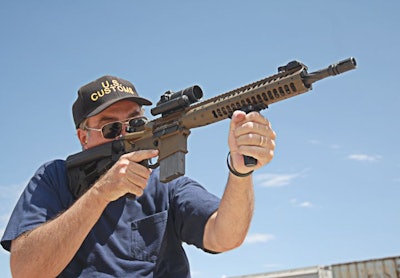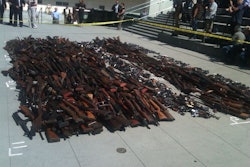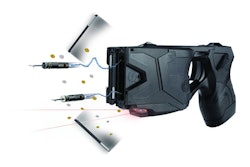 The author fires LWRC's M6A2 special purpose rifle. Photo: Alex Landeen
The author fires LWRC's M6A2 special purpose rifle. Photo: Alex Landeen
For several decades most law enforcement agencies preferred the pistol caliber submachine gun as a tactical entry weapon. This was true for federal, state, and local tactical teams. But now many tactical officers are changing their minds.
The pistol caliber subgun was adopted by law enforcement in a day and age when full size M16s with a 20-inch barrel as well as Colt CAR 15 carbines with 16-inch barrels were in widespread service by certain federal agencies and a growing number of law enforcement tactical teams.
One of the first pistol caliber subguns favored by law enforcement was the 9mm Walther MPK, which ceased production in 1985. When the Walther was no longer available, armorers outfitted their teams with a wide variety of select-fire and full-auto weapons, including the 9mm Smith & Wesson M76 and the 9mm UZI. Today the most common subguns used by American law enforcement are the 9mm Heckler & Koch MP5 in 9mm, .40 S&W, or .45 ACP, and the exotic FNH P90 in 5.7x28mm, which is a favorite of the Secret Service and the FBI.
After the infamous 1997 North Hollywood Shootout in Los Angeles where the bad guys were equipped with armor that stopped pistol rounds, law enforcement agencies began adopting M16s, AR-15s, and M4s as "patrol rifles." This meant that an increasing number of regular patrol personnel began carrying a semi-automatic 5.56mm M4.
But many tactical officers stuck by the pistol-caliber subgun. They liked the quantity of fire that the subguns could concentrate on target, and they liked the compact form of the guns.
This started to change in the last five years, as more and more tactical operators began to favor the M4 for its rifle-caliber power and combat-proven performance in Iraq and Afghanistan. However, many officers still wanted compact entry weapons, so they opted for short-barreled M4 variants.
Even though I am a big fan of using semi-automatic and select-fire rifles and carbines in 7.62mm NATO, for certain applications short-barreled M4s chambered for 5.56mm ammo are the best option. This is especially the case when a tactical team or any law enforcement officer is engaging an armed subject inside a dwelling.
According to my resident ballistics expert Rick Batory, who served in law enforcement and also trained U.S. Air Force Special Ops personnel, the loss of velocity of 5.56mm rounds fired from a 10.5-inch barrel as opposed to a 14.5-inch barrel is approximately 200 feet per second. That's not too bad. Even the difference in fragmentation is reportedly only a loss of approximately 20% between a 10.5-inch M4 and a 14.5-inch model.
The bottom line is that even with its disadvantages a short-barreled 5.56 caliber M4 carbine is still a better weapon to deploy in certain situations than a service pistol or a pistol-caliber subgun.
Recently, I had an opportunity to spend some range time with a select fire LWRC International M6A3 with a 10.5-inch barrel. It was easy to carry, easy to wield, incredibly rugged, and flawlessly reliable.
It also proved to be dead nuts accurate. My colleagues and I have used the M6A3 to successfully engage everything from orange clay discs, to pieces of clay discs, to paper targets, and different size metal plates with tremendous precision at various distances out to 50 yards.
According to Larry Kotz, the Class III SOT FFL dealer who owns the test rifle, the LWRCI M6A3 that I field tested has been flawlessly reliable except for two incidents. On one occasion it failed to fire due to a defective round of ammunition. It also experienced one stoppage due to the use of a defective magazine.
Due to its overall compact size and weight the LWRCI M6A3 with a 10.5-inch barrel is also easy to carry for long periods of time. This is a critical factor that needs to be taken into consideration because law enforcement tactical operators are called out to situations where they are required to maintain containment for many hours. Lighter weapons can help them endure such deployments with enough energy to take decisive action when the waiting ends.
Related:
















